

Tonalism was an artistic style that emerged in the 1880s when American artists began to paint landscape forms with an overall tone of colored atmosphere or mist. Between 1880 and 1915, dark, neutral hues such as gray, brown or blue, often dominated compositions by artists associated with the style. During the late 1890s, American art critics began to use the term “tonal” to describe these works. Two of the leading associated painters were George Inness and James McNeill Whistler.
Dark, neutral shades of color, such as gray, brown or blue, usually dominate such compositions. During the late 1890s, American art critics began using the term “tonal” for these works.
The term tonalism is sometimes also used to describe American landscapes derived from the French Barbizon School, which places special emphasis on mood and shadow.
Two leading painters of these two genres are George Inness and James McNeill Whistler.
History
Tonalism was an artistic style that emerged in the 1880s when American artists began to paint landscape forms with an overall tone of colored atmosphere or mist Between 1880 and 1915, dark, neutral hues such as gray, brown or blue, often dominated compositions by artists associated with the style During the late 1890s, American art critics began to use the term “tonal” to describe these works Two of the leading associated painters were George Inness and James McNeill Whistler
Tonalism, in both forms, was soon overshadowed by the popularity of Impressionism and European Modern Art.
In the late 1890s, American critics began to use the term “tonal” to describe these works. Its principal American representative was George Inness (1825-1894), whose landscapes show the goodness of nature, which testifies to links with the Hudson River School. The second leading painter was James McNeill Whistler.
It is directly influenced by the Barbizon School, and the very word “tonalism” is also used to describe American landscapes inspired by this school.
According to Bram Dijkstra,
“The tonalist art had developed from the principles of the American Transcendentalists of the 1840s… These Transcendentalists, as Brownest Orestes pointed out, had refused to rely on reason alone to explain the meaning of being […]. Tonalism […] was different from other forms of landscape painting, first of all because of the importance given to the philosophical contemplation of emotional analogies between the moods of nature and the spiritual condition of humanity. ”
– Georgia O’Keeffe and the Eros of Place
Australian Tonalism emerged as an art movement in Melbourne during the 1910s.
Tonalism is sometimes used to describe American landscapes derived from the French Barbizon style, which emphasized mood and shadow. Tonalism was eventually eclipsed by Impressionism and European modernism.
Characteristics
The tonalist canvases show a contemplative mode, reveal the equivalences between the lines, a mysterious geometry of the landscape, the volumes, the link between the space and the pictorial, the colors of the landscape and the modulations of the soul.
For example, with Georgia O’Keeffe: “In some paintings such as Black, Gray and Pink Site (Black Place, Gray and Pink, 1949, Oil on Canvas, Georgia O’Keeffe Museum, Santa Fe), the object represented is a abstraction of the hill reduced to its basic structure. A thick concave line suggests a hill. »
Associated artists
Willis Seaver Adams
Joseph Allworthy
Edward Mitchell Bannister
Clarice Beckett
Ralph Albert Blakelock
Emanuele Cavalli
Jean-Charles Cazin
Bruce Crane
Leon Dabo
Elliott Daingerfield
Angel De Cora
Charles Melville Dewey
Thomas Dewing
Charles Warren Eaton
Henry Farrer
Percy Gray
L. Birge Harrison
Arthur Hoeber
George Inness
William Keith
Percy Leason
Xavier Martinez
Arthur Frank Mathews
Max Meldrum
Robert Crannell Minor
John Francis Murphy
Frank Nuderscher
Fausto Pirandello
Henry Ward Ranger
Granville Redmond
Albert Pinkham Ryder
Edward Steichen
Dwight William Tryon
John Twachtman
Clark Greenwood Voorhees
James McNeill Whistler
Alexander Helwig Wyant
Raymond Dabb Yelland
Source from Wikipedia